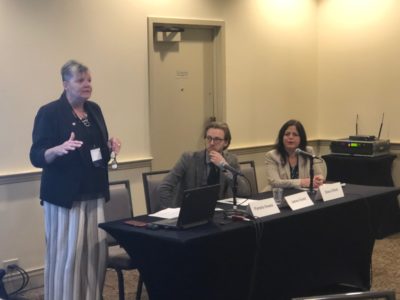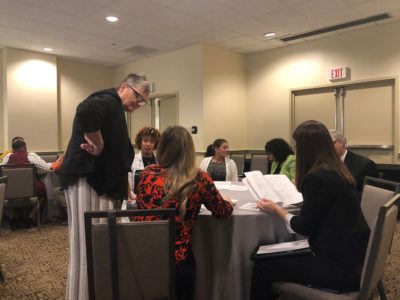“Making an investment in people and helping their development makes all the difference in the world.” – Susan Thomas
 Healthcare organizations nationwide are struggling to find talent, especially for their frontline workforce. As a result, they are turning to apprenticeships – the tried and true solution to addressing workforce needs. It’s no secret in workforce development that apprenticeships are having “a moment,” and for obvious reasons: they are a win-win for employers and employees. Over the course of three sessions at Healthcare Connect in New Orleans, we learned that healthcare apprenticeships are a viable and highly effective solution to filling skills gaps.
Healthcare organizations nationwide are struggling to find talent, especially for their frontline workforce. As a result, they are turning to apprenticeships – the tried and true solution to addressing workforce needs. It’s no secret in workforce development that apprenticeships are having “a moment,” and for obvious reasons: they are a win-win for employers and employees. Over the course of three sessions at Healthcare Connect in New Orleans, we learned that healthcare apprenticeships are a viable and highly effective solution to filling skills gaps.
Track Sessions
Session 1- Healthcare Apprenticeship Models
Session 2- Designing Your Apprenticeship Program: A Step-by-Step Guide
Session 3- How to Identify and Validate Competencies
Healthcare Apprenticeship Models
In the first session, we learned about three slightly different models of healthcare apprenticeships, each with different partners (community, educational, public sector), slightly different requirements and design, but with plenty of commonalities.
Organizations and Presenters
- Pamela Howze, Director, Work-Based Learning, National Fund for Workforce Solutions (Moderator)
- Kelly Wilczak, Workforce Program Specialist, Trinity Health Michigan Region
- Sarah Currier, Dartmouth-Hitchcock
- Susan Thomas, Industry Partnership Director, District 1199C Training & Upgrading Fund
Discussion Highlights
- Making the case to leaders (especially finance) can be challenging, but once launched, apprenticeships quickly demonstrate a clear ROI, especially in terms of retention.
- Similarly, grant funding is a great way to get apprenticeships off the ground, but don’t become dependent on it. Start gathering data right away and be ready to make the case for putting apprenticeships in the budget.
- Pre-apprenticeships are a great way for individuals to brush up on basic skills, including soft skills, and students get to see the work in action, shadow employees, and meet employers who may want to place them in an apprenticeship when they are ready.
- There is no stable state of apprenticeships. Organizations have to be nimble, because the target market keeps changing and the skill needs evolve.
Designing Your Apprenticeship Program – A Step-by-Step Guide
In the next session, we drilled down a bit deeper and were introduced to a step-by-step guide to developing healthcare apprenticeships, courtesy of Healthcare Career Advancement Programs, or H-CAP, who used a nationally recognized program in the Bronx as example. Presenters were quick to point out that although they were presenting this step-by-step guide in a linear fashion, life doesn’t actually work that way (see above about being nimble).
Organizations and Presenters
- Daniel Bustillo, Executive Director, Healthcare Career Advancement Programs
- Selena Griffin-Mahon, Assistant Vice President, BronxCare Health System
- Rebecca Hall, Associate Director, 1199SEIU Training & Upgrading Fund
Discussion Highlights
- Planning is critical. “You must get the planning right, or your program is doomed to fail,” Daniel Bustillo said.
- Apprenticeship programs provide tailored training. The process of designing an apprenticeship program has the added benefit of standardizing the training for a given position, in this case, community health workers. You ask yourself, what does the ideal community health worker look like? What skills do they need?
- Don’t forget the worker’s perspective. BronxCare did a lot of focus groups with frontline workers to determine needs, barriers, etc.
- Apprentices need mentors to succeed. Mentors are critical players in any apprenticeship program, and this came up in the first session as well. You need to be intentional about the entire process that goes into the selection, recruitment and ratio of mentors.
How to Identify and Validate Competencies
The final apprenticeship session of the day was the most detailed. The goal was for attendees to walk away with concrete tools and actions to use when they walk back into the office.
Organizations and Presenters
- Pamela Howze, Director of Work-Based Learning, National Fund for Workforce Solutions
- James Guest, Metrics Reporting
- Diana Elliott, Senior Research Associate, Urban Institute
Discussion Highlights
- ONET can be used to identify occupational and foundational competencies for a given position, and to facilitate common discussions among stakeholders.
- A job analysis model can help identify skills that you might not automatically think of. For example, the customer service side of environmental services is very important. Sometimes an EVS worker is the first point of contact for a patient’s family trying to find the right room.
- The Urban Institute’s Competency-Based Occupational Framework is Department of Labor-approved and industry vetted. The framework is an effort to create standards and have off-the-shelf frameworks for anyone to use—they are iterative, interactive, and non-proprietary. “The idea is to do good work and share it with people. We could get farther if we were sharing,” said Elliott.
Panelists throughout the day addressed the business case—it’s clear that employers are seeing the benefit of investing in current and new workers through apprenticeships. But the most rewarding win is the stories of apprentices themselves. Whether it’s the individuals who caught the “healthcare bug” and have gone on to enroll in nursing or even physician assistant programs, or the person who has landed a medical assistant position that they love and are happy and thriving, apprenticeships are making an impact on the lives of staff members themselves.
Learn about the other workshop tracks at Healthcare Connect:
Designing and Marketing Your Talent Development Strategy
Developing Pipelines and Pathways for Frontline Workers
Adopting Equity and Inclusion Practices for Frontline Workers
The National Fund for Workforce Solutions and Hope Street Group partnered to convene members of CareerSTAT and the Health Career Pathways Network in New Orleans on October 24 and 25, 2018. Healthcare Connect brought together nearly 200 healthcare professionals to share best practices in developing their frontline workforce in full-group sessions and selected breakout workshops. Learn more about CareerSTAT and the Health Career Pathways Network (HCPN).



